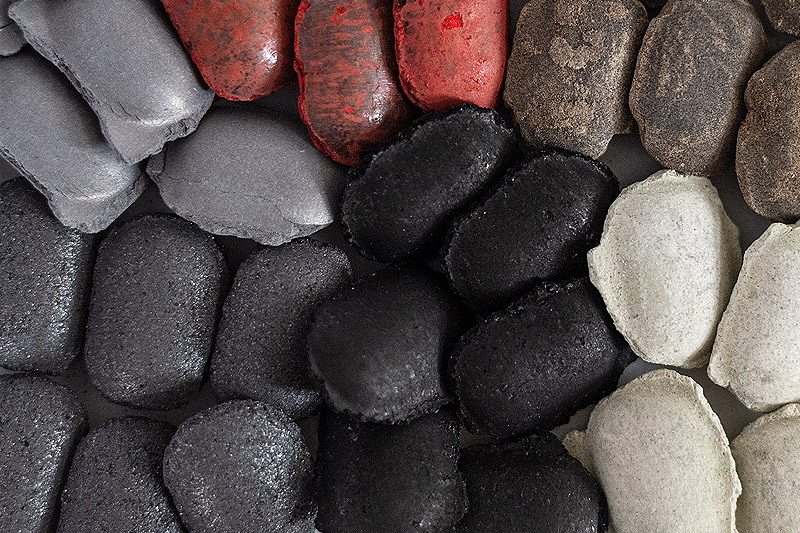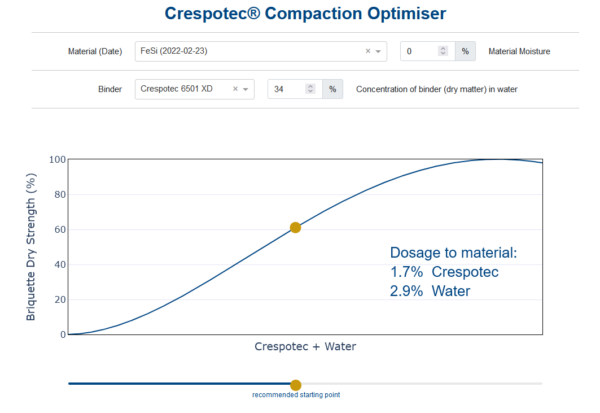The Crespotec® Compaction Optimiser: Efficient recycling of valuable raw materials
Production facilities often generate side streams in the form of chips, grinding sludge or other particles. To date, at least until now, disposing of them is no option, and finding the optimum dosage of water and wheat-based binder for briquetting the raw materials poses a time-consuming and costly task. With the Crespotec® Compaction Optimiser (CCO), C&D Technical Applications now offers a new type of software to calculate the optimum addition quantities. The dosage can be kept low, while briquette properties are optimised and costs reduced.
Challenges of recycled raw materials
The processing of metals and other raw materials regularly results in producing waste in the form of sludges, powders, chips or powdered abrasives. These by-products’ light weight makes them hard to handle, as the dust hazard is high. What is more, the light particles are not easy to melt. Rather, they would be stirred up and enter the exhaust air systems.
To find a way around all of these obstacles, the materials are pressed into abrasion-resistant briquettes. Thanks to their small volume, the briquettes are easy to store and transport. Briquetting requires an optimal mixing ratio of water and binder. Often, these calculations are tedious, time- and resource-consuming and result in trial and error efforts. What if there were a way to perform this calculation quickly and easily?
Benefits of calculation by software
Software reduces the development cycle, by eliminating time-consuming and material-intensive trials. The drying costs can be minimised by using the appropriate mixing ratio, which additionally reduces the total cost of ownership. Using the software, only small quantities of the customer raw material to be briquetted are required for analysis. Changeovers in production or fluctuating raw material qualities can also be calculated with little effort. Manufacturers can use the tool to increase operational efficiency, while fully exploiting the recycling potential of industrial raw materials. As such, the use of compaction software not only benefits the companies themselves, but also the environment.

Step by step to the optimum mixing ratio
The process, from contacting the company, right up to using the Crespotec® Compaction Optimiser takes place in seven steps. After filling out the contact form, the sales department contacts the company and, among other things, requests initial information on raw material, technology and briquette requirements. The customer then sends a kilogram of the raw material that is to be briquetted to the C&D team to analyse the materials in the laboratory for technological properties. These include information on particle size distribution, particle shape, bulk density, specific surface area, and microporosity. Depending on the product, the appropriate wheat-based binder is also selected from the C&D range. Then what happens is what previously used to require entire series of tests: The software calculates how much binder and water is needed to obtain a stable briquette. Properties, such as green strength can also be taken into account. Companies can use the log-in data for the software to obtain the calculated formula and make individual adjustments. The tool then changes the binder application again, if necessary. C&D also offers to verify the results with a roll press on a laboratory scale.

About Crespotec® binders
Crespotec® binders from C&D Technical Applications are based on the natural raw material wheat. Unlike synthetic binders, they burn in a CO2-neutral and low-smoke manner. This makes them more environmentally friendly. All information about Crespotec® binders: https://crespeldeitersgroup.com/cd-technical-applications/applications-solutions/
The idea behind the Crespotec® Compaction Optimiser (CCO)

The demand for an efficient way to return valuable by-products to production was repeatedly mirrored to the C&D Technical Applications team by customers. A cross-departmental project team with experts from Research & Development and IT worked on the data basis and the mode of operation for more than a year. Numerous tests on a roll press, with a wide range of raw materials led to model equations and, ultimately, to a powerful tool that was not found in this form yet.
Outlook: Continuous development
The C&D team is working intensively on making it usable for other process technologies, such as stamp presses or cold extruders. Carsten Mergelmeyer, Sales Manager C&D Technical Applications, emphasises: “When implementing software, there always are development opportunities. Now, the most important thing for us is to expand our database with more data points and raw material types. We also want to make the tool applicable to other recycling technologies. All in all, we would like to keep expanding the Crespotec® Compaction Optimiser, allowing as many companies as possible in the metals and recycling industry to benefit from it.”